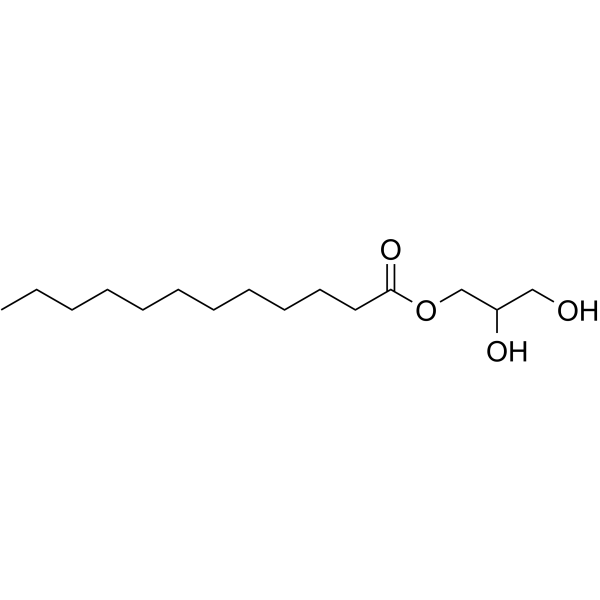UNII:WR963Y5QYW

UNII:WR963Y5QYW structure
|
Common Name | UNII:WR963Y5QYW | ||
|---|---|---|---|---|
| CAS Number | 142-18-7 | Molecular Weight | 274.396 | |
| Density | 1.0±0.1 g/cm3 | Boiling Point | 397.4±22.0 °C at 760 mmHg | |
| Molecular Formula | C15H30O4 | Melting Point | 63ºC | |
| MSDS | Chinese USA | Flash Point | 135.6±15.8 °C | |
|
Surfactants, aromatic and isoprenoid compounds, and fatty acid biosynthesis inhibitors suppress Staphylococcus aureus production of toxic shock syndrome toxin 1.
Antimicrob. Agents Chemother. 53 , 1898-906, (2009) Menstrual toxic shock syndrome is a rare but potentially life-threatening illness manifest through the actions of Staphylococcus aureus toxic shock syndrome toxin 1 (TSST-1). Previous studies have shown that tampon additives can influence staphylococcal TSST-... |
|
|
Mometasone furoate-loaded cold processed oil-in-water emulsions: in vitro and in vivo studies.
Drug Deliv. 22 , 562-72, (2015) Over the years, research has focused on strategies to increase benefit/risk ratio of corticoids. However, vehicles intended for topical glucocorticoids delivery with an improved benefit/risk ratio are still on demand. The aim of this work was the in vitro and... |
|
|
Characterization and antimicrobial activity of a pharmaceutical microemulsion.
Int. J. Pharm. 395 , 154-160, (2010) The characterization of a pharmaceutical microemulsion system with glycerol monolaurate as oil, ethanol as cosurfactant, Tween 40 as surfactant, sodium diacetate and water, and the antimicrobial activities against Escherichia coli, Staphylococcus aureus, Baci... |
|
|
Efficiency of monolaurin in mitigating ruminal methanogenesis and modifying C-isotope fractionation when incubating diets composed of either C3 or C4 plants in a rumen simulation technique (Rusitec) system.
Br. J. Nutr. 102 , 1308-1317, (2009) Mitigation of methanogenesis in ruminants has been an important goal for several decades. Free lauric acid, known to suppress ruminal methanogenesis, has a low palatability; therefore, in the present study the aim was to evaluate the mitigation efficacy of it... |
|
|
A new perspective on the use of plant secondary metabolites to inhibit methanogenesis in the rumen.
Phytochemistry 71 , 1198-1222, (2010) Recently, greenhouse gas emissions have been of great concern globally. Ruminant livestock due to production of methane during normal fermentation in the rumen contributes substantially to the greenhouse effects. During the recent decade, a paradigm shift has... |
|
|
Effects of monolaurin on ruminal methanogens and selected bacterial species from cattle, as determined with the rumen simulation technique.
Anaerobe 17 , 232-238, (2011) Before being able to implement effective ruminal methane mitigation strategies via feed supplementation, the assessment of side effects on ruminal fermentation and rumen microbial populations is indispensable. In this respect we investigated the effects of mo... |
|
|
Inactivation of Cronobacter spp. (Enterobacter sakazakii) in infant formula using lactic acid, copper sulfate and monolaurin.
Lett. Appl. Microbiol. 50 , 246-251, (2010) To investigate the effect of lactic acid (LA), copper (II), and monolaurin as natural antimicrobials against Cronobacter in infant formula.The effect of LA (0.1, 0.2 and 0.3% v/v), copper (II) (10, 50 and 100 microg ml(-1)) and monolaurin (1000, 2000, and 300... |
|
|
Design and evaluation of Lumefantrine - Oleic acid self nanoemulsifying ionic complex for enhanced dissolution.
Daru 21 , 27, (2013) Lumefantrine, an antimalarial molecule has very low and variable bioavailability owing to its extremely poor solubility in water. It is recommended to be taken with milk to enhance its solubility and bioavailability. The aim of present study was to develop a ... |
|
|
In vitro surfactant structure-toxicity relationships: implications for surfactant use in sexually transmitted infection prophylaxis and contraception.
PLoS ONE 6 , e19850, (2011) The need for woman-controlled, cheap, safe, effective, easy-to-use and easy-to-store topical applications for prophylaxis against sexually transmitted infections (STIs) makes surfactant-containing formulations an interesting option that requires a more fundam... |
|
|
Glycerol monolaurate does not alter rhesus macaque (Macaca mulatta) vaginal lactobacilli and is safe for chronic use.
Antimicrob. Agents Chemother. 52 , 4448-54, (2008) Glycerol monolaurate (GML) is a fatty acid monoester that inhibits growth and exotoxin production of vaginal pathogens and cytokine production by vaginal epithelial cells. Because of these activities, and because of the importance of cytokine-mediated immune ... |